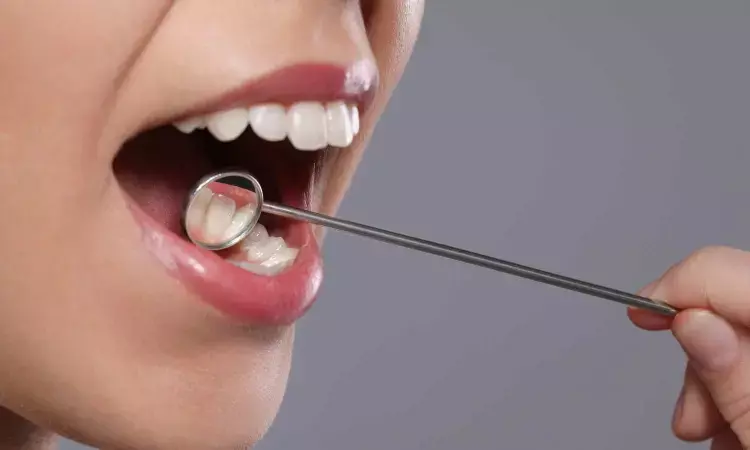- Home
- Medical news & Guidelines
- Anesthesiology
- Cardiology and CTVS
- Critical Care
- Dentistry
- Dermatology
- Diabetes and Endocrinology
- ENT
- Gastroenterology
- Medicine
- Nephrology
- Neurology
- Obstretics-Gynaecology
- Oncology
- Ophthalmology
- Orthopaedics
- Pediatrics-Neonatology
- Psychiatry
- Pulmonology
- Radiology
- Surgery
- Urology
- Laboratory Medicine
- Diet
- Nursing
- Paramedical
- Physiotherapy
- Health news
- Fact Check
- Bone Health Fact Check
- Brain Health Fact Check
- Cancer Related Fact Check
- Child Care Fact Check
- Dental and oral health fact check
- Diabetes and metabolic health fact check
- Diet and Nutrition Fact Check
- Eye and ENT Care Fact Check
- Fitness fact check
- Gut health fact check
- Heart health fact check
- Kidney health fact check
- Medical education fact check
- Men's health fact check
- Respiratory fact check
- Skin and hair care fact check
- Vaccine and Immunization fact check
- Women's health fact check
- AYUSH
- State News
- Andaman and Nicobar Islands
- Andhra Pradesh
- Arunachal Pradesh
- Assam
- Bihar
- Chandigarh
- Chattisgarh
- Dadra and Nagar Haveli
- Daman and Diu
- Delhi
- Goa
- Gujarat
- Haryana
- Himachal Pradesh
- Jammu & Kashmir
- Jharkhand
- Karnataka
- Kerala
- Ladakh
- Lakshadweep
- Madhya Pradesh
- Maharashtra
- Manipur
- Meghalaya
- Mizoram
- Nagaland
- Odisha
- Puducherry
- Punjab
- Rajasthan
- Sikkim
- Tamil Nadu
- Telangana
- Tripura
- Uttar Pradesh
- Uttrakhand
- West Bengal
- Medical Education
- Industry
Radiation Timing affects Bond Strength of universal adhesive in Dental Restorations, suggests study

Researchers have found in a new study that radiation administered before dental restoration leads to weaker bond strength of universal adhesive compared to radiation given after restoration.
The method of applying a universal adhesive does not influence the bond strength. Performing dental restoration before radiation treatment is therefore reSuccessful restorative procedures, particularly for patients undergoing head and neck radiotherapy, rely on a robust adhesive interface. Since radiotherapy may alter dental tissues and compromise bonding, this study evaluated how the timing of radiation exposure affects the microtensile bond strength (µTBS) of a universal adhesive to dentin with different application modes.
Forty-two human third molars were used in this study. Mid-coronal dentin was prepared using a low-speed saw and polished with silicon carbide paper.
The samples were randomly divided into 3 groups (n = 6) according to the timing of radiation exposure (no radiation, control; radiation after restoration, F-RT; and radiation before restoration, RT-F). A single radiation dose of 70 Gy was administered to the samples after restoration (F-RT) and before restoration (RT-F). The samples were further divided into 2 subgroups according to the application mode of a universal adhesive (Single Bond Universal adhesive, 3 M Oral Care, St. Paul, MN, USA): etch-and-rinse (ER) or self-etch (SE) mode. After adhesive application, the resin composite was constructed and stored in distilled water at 37 °C for 24 h. Six resin-bonded teeth per group were processed for the µTBS test.
The data were analyzed by two-way ANOVA followed by Duncan's test (p < 0.05). Fractured surfaces were observed under a scanning electron microscope (SEM). Additional teeth were prepared for resin‒dentin interface observation (n = 1) and observed using an SEM. RESULTS: The application mode of the universal adhesive had no influence on the µTBS of dentin, regardless of irradiation (p = 0.670). The µTBS values of the control groups were not significantly different from those of the F-RT group but were significantly higher than those of the RT-F group for both application modes.
The resin‒dentin interfaces of the samples were similar among the control, F-RT and RT-F groups. More abundant and longer resin tags were observed when the universal adhesive was bonded in ER mode. Compared with radiation after restoration, radiation before restoration resulted in an inferior bond strength. The application mode of a universal adhesive had no effect on the bond strength.
Reference:
Saikaew, Pipop, et al. "Effect of Radiation Therapy On the Dentin Bond Strength of a Universal Adhesive." BMC Oral Health, vol. 25, no. 1, 2025, p. 812.
=
Dr. Shravani Dali has completed her BDS from Pravara institute of medical sciences, loni. Following which she extensively worked in the healthcare sector for 2+ years. She has been actively involved in writing blogs in field of health and wellness. Currently she is pursuing her Masters of public health-health administration from Tata institute of social sciences. She can be contacted at editorial@medicaldialogues.in.
Dr Kamal Kant Kohli-MBBS, DTCD- a chest specialist with more than 30 years of practice and a flair for writing clinical articles, Dr Kamal Kant Kohli joined Medical Dialogues as a Chief Editor of Medical News. Besides writing articles, as an editor, he proofreads and verifies all the medical content published on Medical Dialogues including those coming from journals, studies,medical conferences,guidelines etc. Email: drkohli@medicaldialogues.in. Contact no. 011-43720751


